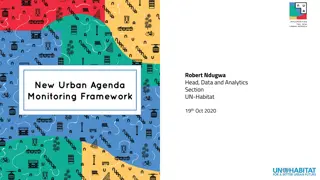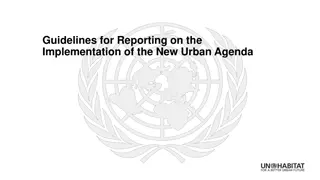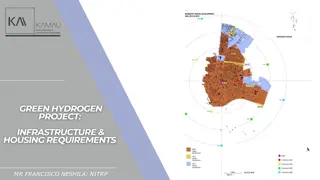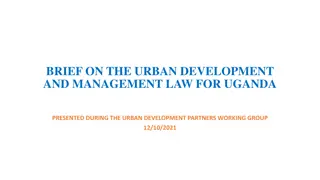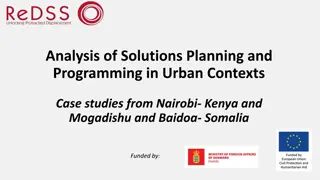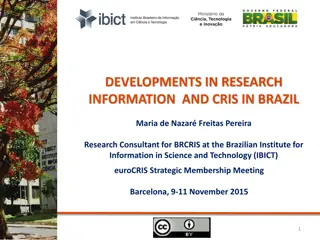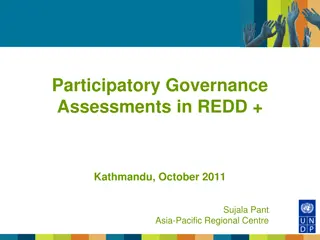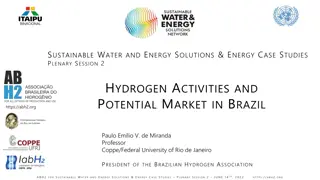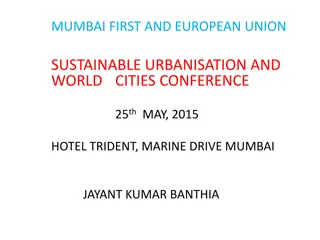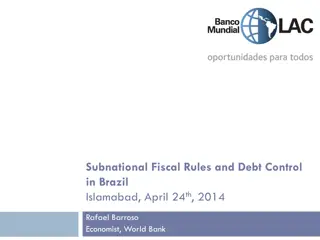Governance Framework and Urban Aspirations in the Region of ABC, Brazil
The content explores the formal position and autonomy of regional government within the broader governance framework in the Region of ABC, Brazil. It delves into the intentions, aspirations, and stated objectives of the regional government in relation to urban futures, highlighting the unique challenges and opportunities faced in the Metropolitan Region of Sao Paulo and ABC. The focus is on the need for adaptive and transformative governance to drive large city development within the existing decentralized federal system of Brazil.
Download Presentation

Please find below an Image/Link to download the presentation.
The content on the website is provided AS IS for your information and personal use only. It may not be sold, licensed, or shared on other websites without obtaining consent from the author. Download presentation by click this link. If you encounter any issues during the download, it is possible that the publisher has removed the file from their server.
E N D
Presentation Transcript
BRICS + CITY LAB II COLLOQUIUM Adaptive and Transformative Governance for Large City Development JEFERSON TAVARES BRAZIL ABC Region Inter-Municipal Consortium office Professor of Centro Universit rio das Faculdades Metropolitanas Unidas Moscow - 2016
THE EXPERIENCE OF THE REGION OF ABC A TERRITORIAL ASSOCIATION IN WITH INTERMUNICIPAL COOPERATION NETWORK
What is the formal position of region government within the broader governance framework? How autonomous is it of levels of government (including in relation to finances)? GEOGRAPHICAL AND ADMINISTRATIVE CONTEXT Region of ABC in Brazil Region of ABC in the state of Sao Paulo
What is the formal position of region government within the broader governance framework? How autonomous is it of levels of government (including in relation to finances)? GEOGRAPHICAL AND ADMINISTRATIVE CONTEXT Brazil is a federation decentralized since the Constitution of 1988, formed by three federative entities: Federation States Counties The three units have political, administrative and budget autonomy. However, there is a lack of an intermediate scale of governance (with attribution of responsibilities for planning actions) that legitimizes new territorial arrangements, in the Regional Scale, between states and municipalities.
What are the intentions/preoccupations/aspirations of regional government? What are the stated objectives of regional government in relation to urban futures? METROPOLITAN REGION OF S O PAULO AND THE REGION OF ABC
What are the intentions/preoccupations/aspirations of regional government? What are the stated objectives of regional government in relation to urban futures? METROPOLITAN REGION OF S O PAULO AND THE REGION OF ABC The Metropolitan Regions are territorial organizations, but they do not have autonomy for decisions. In 2015, at the federal level, the Metropolis Statute was approved, which requires the elaboration of the PDUI (Integrated Urban Master Plan) that will attempt to integrate unique guidelines for the municipalities of the Metropolitan Regions.
What are the relational capabilities (embeddedness) of regional government? What is the history and background to these? Which of them does city government pay most attention to? THE REGION OF ABC The Region of ABC was formed by seven municipalities: Santo Andr , S o Bernardo do Campo, S o Caetano do Sul, Diadema, Mau , Ribeir o Pires and Rio Grande da Serra. It currently has a population of 2,544,554 inhabitants and has
What are the relational capabilities (embeddedness) of regional government? What is the history and background to these? Which of them does city government pay most attention to? THE REGION OF ABC The Region of ABC was formed by seven municipalities: Santo Andr , S o Bernardo do Campo, S o Caetano do Sul, Diadema, Mau , Ribeir o Pires and Rio Grande da Serra. It currently has a population of 2,544,554 inhabitants and has HISTORICAL affinities All municipalities were formed from: S o Bernardo do Campo and Santo Andr
What are the relational capabilities (embeddedness) of regional government? What is the history and background to these? Which of them does city government pay most attention to? THE REGION OF ABC The Region of ABC was formed by seven municipalities: Santo Andr , S o Bernardo do Campo, S o Caetano do Sul, Diadema, Mau , Ribeir o Pires and Rio Grande da Serra. It currently has a population of 2,544,554 inhabitants and has TERRITORIAL affinities The Region is divided among: Urbanized area Springfield area
What are the relational capabilities (embeddedness) of regional government? What is the history and background to these? Which of them does city government pay most attention to? THE REGION OF ABC The Region of ABC was formed by seven municipalities: Santo Andr , S o Bernardo do Campo, S o Caetano do Sul, Diadema, Mau , Ribeir o Pires and Rio Grande da Serra. It currently has a population of 2,544,554 inhabitants and has ECONOMIC affinities The Region forms a national INDUSTRIAL CLUSTER REA (EM M2) COM USO DO SOLO INDUSTRIAL NA RMSP REGI O COM MAIOR CONCENTRA O DE REA INDUSTRIAL DA RMSP
What are the relational capabilities (embeddedness) of regional government? To what extent is there coherence or divergence in the visions/policies/strategies for the region across the levels? MUNICIPAL POLICIES X REGIONAL CONFLICTS There is unity in historical formation, but there is no unity in territorial management. Each city adopts a specific zoning that results in conflicts between uses Industrial area x residential area Preservation area x industrial area Border conflicts MAPA DO ZONEAMENTO DE CADA MUNIC PIO E SEUS CONFLITOS
What are the relational capabilities (embeddedness) of regional government? To what extent is there coherence or divergence in the visions/policies/strategies for the region across the levels? In short, we have territorial and management conflicts on a regional scale. The region is not treated as a federative entity, that is, it does not have the autonomy to respond to these problems. What paths have been adopted?
What are the adaptive capabilities of regional government? Does the region government incentivise innovation within the bureaucracy? In 1990, the Consortium of ABC was created and became the first multisectorial consortium of public law and autarchic nature of the country in February 2010. It influenced the formulation of the Federal Consortium of ABC is a Consortia Law, Law no. 11,107, of April 6, voluntary form of collaboration 2005. between municipalities Currently, it is consolidated as a regional- local strategy for spatial planning and funding for the financing of sectoral public policies
Capacities for Planning and Managing the Built Environment How effective is regional government in financing and delivering infrastructure? In 2013 the Consortium contracted the Regional Mobility Plan to raise federal resources for the construction of integrated bus corridors. In isolation, the smaller municipalities did not have indebtedness capacity. The solution: the Consortium requested resources for the seven municipalities and the larger and more developed municipalities assumed the largest fraction of the debts, allowing the release of the entire resource MAPA DOS CORREDORES DE NIBUS DO GRANDE ABC
How effective is regional government in coordinating built environment functions? What mechanisms and capacities are available to achieve coordination? REGIONAL MASTER PLAN Attempt to overcome sectorial policies and municipal autarchy with a Regional Master Plan. In progress, since 2015, by the Consortium, the seven municipalities and the Federal University of ABC
How effective is regional government in coordinating built environment functions? What mechanisms and capacities are available to achieve coordination? REGIONAL ZONING Technical and political action to transform the territory Existing zoning in each municipality: land use conflicts Proposal of territorial compartments: groupings of areas with similar characteristics Unified zoning: avoid conflicts of land use between municipalities and integrate public policies
How effective is regional government in coordinating built environment functions? Where are the critical points where co-ordination is required? MAIN CHALLENGES 1. Overcoming the localist tradition Municipalities concentrate decision and investment power, because all financing is municipalized. 2. Build a new governance standard that integrates territory beyond administrative boundaries and sectoral policies Mediating the conflict between industrial X environmental X urban interests. 3. To strengthen the relation between the different scales (federal, metropolitan and municipal state) Currently, the PDR tries to dialogue with the Plan of Action of the Macrometropole and the Integrated Urban Master Plan
How to develop adaptive and transformative capacities of the region? BUILD A NEW AGENDA TO REVIEW THE INSTITUTIONAL ARRANGEMENT 1. Redefine how to make new territorial associations 2. To value the intermunicipal relations 3. Adopt a new model of interfederative governance 4. To legitimize the regions as a federative entity 5. Prioritize a metropolitan fund or regional investment fund 6. Inserting the civil society debate into regional and metropolitan plans
BRICS + CITY LAB II COLLOQUIUM Adaptive and Transformative Governance for Large City Development JEFERSON TAVARES BRAZIL ABC Region Inter-Municipal Consortium office Professor of Centro Universit rio das Faculdades Metropolitanas Unidas THANKS Moscow - 2016
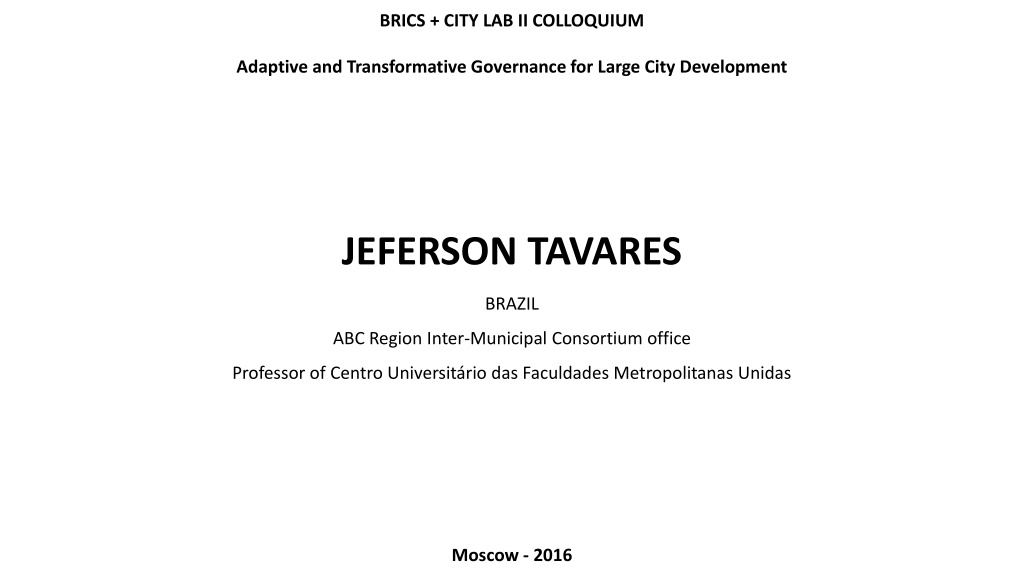


![Halal_Chicken_from_Brazil-_Ensuring_Quality_and_Authenticity[1]](/thumb/86918/halal-chicken-from-brazil-ensuring-quality-and-authenticity-1.jpg)
